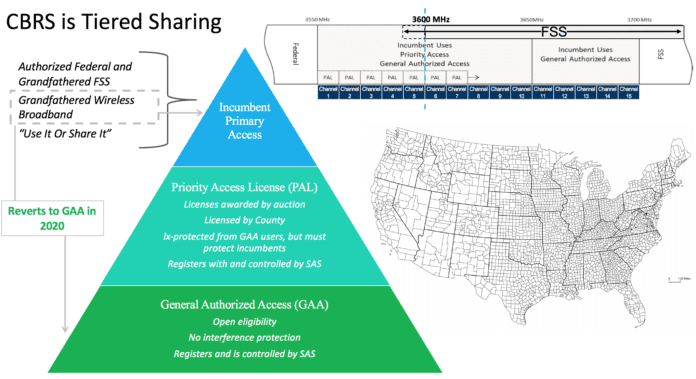CBRS waiting for FCC on full commercialization and is on evolutionary path to 5G
Around the world, the 3.5 GHz band has been tapped by operators as key mid-range 5G spectrum. In the U.S. that frequency, referred to as the Citizens Broadband Radio Service band, is set aside for LTE services. A spectrum access system, based on a three-tiered licensure system, will protect incumbents while opening up the band for operators to augment capacity and for enterprises and industries to stand up private networks.
And while the focus has been on deploying LTE in the CBRS band, the cross-industry CBRS Alliance says it will work out technical specifications to make shared access to 3.5 GHz compatible with 3GPP’s 5G New Radio air interface. There’s a lot of benefits that will come with this move, chief among them simplified device development and commercialization based on global alignment around 5G in 3.5 GHz.
“Utilizing the CBRS band can be a key enabler for making 5G deployments possible. The Alliance is hard at work developing technical specifications to ensure that OnGo supports 5G applications as seamlessly as traditional LTE services,” Gary Boudreau, chair of the CBRS Alliance’s Technical Working Group, said in a statement. “The specifications in development include addressing coexistence requirements to ensure seamless interoperability between LTE and 5G NR in and out of Band 48, certificate-based authentication, and more.”
And while that update to 5G is in the works, there’s significant interest today in using 3.5 GHz by operators to aggregate it with other frequencies and by enterprises to set up private LTE networks. So let’s take stock of where we are today.
CommScope’s Mark Gibson, director of business development and regulatory policy, described the long process that has resulted in CBRS commercial-readiness and said, “One of the reasons why it’s taken so long is people wanted to make sure we got this right. Right now we’re past this process called initial commercial deployment. We are waiting for the [Federal Communications] Commission to review out initial commercial deployment reports and issue a public notice indicating that we’re ready to actually begin full commercial operation.”
During the ICD process, CommScope and other SAS administrators set up networks to field test “operations through the SAS and keep track of activity,” Gibson said. The SAS works with an environment sensing network to detect incumbent transmissions and other variables then feed that data back into the SAS.
“The SAS incorporates information from the FCC, from peer SASs, from this element called a domain proxy…that helps manage devices that may not necessarily be able to talk through the SAS,” Gibson said.

